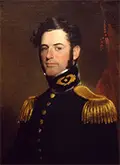Confederate General Robert E. Lee
Robert E. Lee was the head of the Confederate forces during the American Civil War and one of the war's most recognizable figures. 
He was born on Jan. 19, 1807, in Stratford Va. His father was Henry "Light Horse Harry" Lee, a former governor of Virginia and hero of the Revolutionary War. In 1829, Lee graduated from West Point second in his class (behind only Charles Mason, who didn't continue in the military but instead went on to a legal career in Iowa) and finished without suffering any demerits. He left the academy with an engineering commission and worked in Georgia and Missouri. In 1831, he married Mary Custis, whose grandmother was Martha Washington; together, they had seven children. When the Mexican-American War began, the U.S. Army top commander, Gen. Winfield Scott, named Lee to his staff. The young Robert found plenty of work mapping terrain and at one point led Scott's men into battle. After the war ended, Lee returned to the Washington, D.C., area and, promoted to the rank of colonel, continued his engineering work. He became superintendent of West Point; one of the changes implemented while he had this position was the adding of a fifth year to the program of study. He gained the rank of lieutenant colonel and accepted the command of the 2nd Cavalry regiment, assigned to Texas. He took a leave of absence when his father-in-law died, sorting out George Custis's will; as part of his inheritance, he became overseer of the Arlington plantation, which was staffed largely by slaves.  In 1859, Lee accepted a special commission to lead the force of soldiers who went to Harpers Ferry to stop the attempted seizure of the federal arsenal there by noted abolitionist John Brown. Lee led a force of Marines who captured Brown and his co-conspirators. The following year, after Abraham Lincoln was elected President, seven southern states seceded from the Union and eventually formed the Confederate States of America. Scott asked Lee to head up the U.S. Army and bring the Southern states back into the fold. Lee, who had opposed secession but was still more devoted to his state of Virginia, said that he could not lead troops against his fellow Virginians and offered his services instead to Confederate President Jefferson Davis, who accepted. 
Lee's career in the Confederate military began as an advisor to Davis. He gained combat experience in western Virginia and found defeat at the hands of Gen. George McClellan at Rich Mountain. It was in this part of the state that he gained Traveller, the horse that carried him through most of the war. When Gen. Joseph Johnston was wounded at the Battle of Seven Pines, Davis appointed Lee to take over Johnston's command of the Army of Northern Virginia. Lee, more aggressive a commander than Johnston, turned the tables on the Union army, forcing McClellan and the Army of the Potomac to call off the Peninsula Campaign and go back north. Next page > Victory after Victory > Page 1, 2, 3, 4, 5 |
|
Social Studies for Kids
copyright 2002–2024
David White





